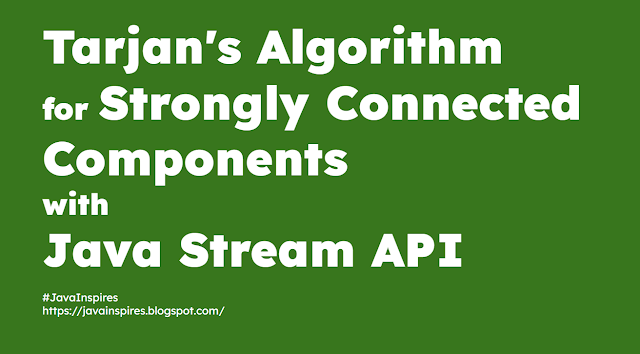Exploring Tarjan's Algorithm for Strongly Connected Components with Java Stream API
Introduction:
Strongly Connected Components (SCCs) play a crucial role in graph theory, helping to identify groups of nodes within a directed graph where every node is reachable from every other node. Tarjan's Algorithm is a classic method for efficiently finding SCCs in a graph. In this blog post, we'll delve into the implementation of Tarjan's Algorithm using Java, leveraging the power of the Java Stream API for a concise and elegant solution.
Understanding Tarjan's Algorithm:
Tarjan's Algorithm is a graph algorithm used to find the strongly connected components in a directed graph. The algorithm was developed by Robert Tarjan in 1972 and is based on depth-first search traversal. It efficiently identifies SCCs by maintaining information about the depth of each node in the traversal and the lowest reachable ancestor of each node. This allows it to identify back edges and thus detect SCCs.
advertisement
Using Java Stream API for Tarjan's Algorithm:
Java Stream API provides a powerful way to work with collections and perform operations on them in a functional manner. Leveraging the Stream API can lead to concise and readable code. Let's see how we can implement Tarjan's Algorithm for finding SCCs using Java Stream API.
Implementation Steps:
1. Define a class to represent a graph node, including properties to track the node index, lowlink value, and whether the node is on the stack.
2. Implement Tarjan's Algorithm using a depth-first search traversal function that updates the lowlink values and identifies SCCs.
3. Utilize the Stream API to perform operations on collections, such as filtering and mapping, to streamline the implementation.
4. Test the implementation with sample directed graphs to validate its correctness and efficiency.
Sample Code:
import java.util.*;class GraphNode {int index;int lowlink;boolean onStack;GraphNode(int index) {this.index = index;this.lowlink = index;this.onStack = false;}}public class TarjansAlgorithm {private int index;private Deque<GraphNode> stack;private List<List<Integer>> graph;private List<List<Integer>> stronglyConnectedComponents;public List<List<Integer>> findSCCs(List<List<Integer>> graph) {this.index = 0;this.stack = new ArrayDeque<>();this.graph = graph;this.stronglyConnectedComponents = new ArrayList<>();for (int i = 0; i < graph.size(); i++) {if (graph.get(i) != null && !graph.get(i).isEmpty()) {if (graph.get(i).get(0) == -1) {continue; // Skip visited nodes}dfs(i);}}return stronglyConnectedComponents;}private void dfs(int v) {GraphNode node = new GraphNode(v);stack.push(node);node.onStack = true;node.lowlink = index;index++;for (int neighbor : graph.get(v)) {if (graph.get(neighbor) != null && !graph.get(neighbor).isEmpty()) {if (graph.get(neighbor).get(0) == -1) {continue; // Skip visited nodes}if (stack.contains(new GraphNode(neighbor))) {node.lowlink = Math.min(node.lowlink, neighbor);} else {dfs(neighbor);node.lowlink = Math.min(node.lowlink, neighbor);}}}if (node.lowlink == v) {List<Integer> component = new ArrayList<>();GraphNode w;do {w = stack.pop();w.onStack = false;component.add(w.index);} while (w.index != v);stronglyConnectedComponents.add(component);}}public static void main(String[] args) {TarjansAlgorithm tarjansAlgorithm = new TarjansAlgorithm();List<List<Integer>> graph = new ArrayList<>();graph.add(Arrays.asList(1)); // Node 0 -> Node 1graph.add(Arrays.asList(2)); // Node 1 -> Node 2graph.add(Arrays.asList(0)); // Node 2 -> Node 0List<List<Integer>> sccs = tarjansAlgorithm.findSCCs(graph);System.out.println("Strongly Connected Components: " + sccs);}}
advertisement
Conclusion:
In this blog post, we've explored Tarjan's Algorithm for finding strongly connected components in a directed graph and implemented it using Java Stream API. By leveraging the Stream API, we were able to write concise and readable code while efficiently identifying SCCs in a graph. Tarjan's Algorithm remains a fundamental tool in graph theory and finding its implementation in Java can be a valuable addition to any programmer's toolkit.
Tags:
Java Stream API
